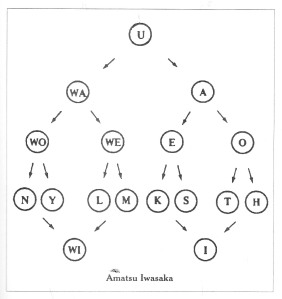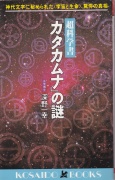(L) Kada’s Inari Koden Chart. (R) Yamaguchi’s Futomani no Mitama Chart.
Editor’s Note: This is an English rendering from the Japanese book, Koshinto Gyoho Nyumon by Omiya Shirou, pp 100-107.
Yamaguchi Shido in the mid-19th century wrote a book that integrated the strange symbols found in two ancient scrolls into a metaphysical system of Kototama.
Yamaguchi Shido
In 1765 Yamaguchi Shido, the son of a wealthy farmer, was born in Awanokuni which is the modern-day Kamogawa-shi in Chiba prefecture. He was a child prodigy and learned Chinese literature at a young age. When he was 25 or 26, he moved to Edo to live with his uncle. He started the study of kokugaku, which is the study of ancient Japanese literature.
Futomani no Mitama/Kagotama Chart
The Yamaguchi family had handed down over the generations an ancient scroll that contained a mysterious chart known as Futomani no Mitama, also called Kagotama. Yamaguchi wanted to unwrap the secret of this chart. After three decades of studying, he came to understand that Futomani no Mitama told the secret about ancient kototama, the power of sound. But he did not quite understand the kototama.
Inari Koden/Mizuhi no Ontsutae Chart
The Inari Koden or Mizuhi no Ontsutae chart was handed down in the prominent Kada family. The Kada family, together with the Hata, of Kyoto were hereditary priests of the Inari shrine in Yamashiro no kuni, the present Fushimi Inari Taisha shrine in Kyoto. The noted kokugaku scholar, Kada no Azumaro (1669-1736) possessed this chart at one time. Azumaro has a lovely shrine at Fushimi Inari which I visited in 2012. Azumaro passed the chart to his adopted child, Tamiko, who in turn passed it to Kada no Noriyuki.
Yamaguchi Shido studied classical Japanese literature under Kada no Noriyuki. Later he taught nobles at the Imperial Court in Kyoto. During these studies, Yamaguchi was given the Inari Koden chart. [Inari Koden probably means the ancient document of Inari.] The secret symbols written in the chart enabled him to solve his question of the ages about the Futomani no Mitama chart.
Mizuho no Tsutae by Yamaguchi Shido, an integration of the two documents
By receiving the Inari Koden, Shido became more confident about his study. In the year Bunsei 1, 1818, he returned to Edo and spent five years in developing a solid base for his study. In the year Tempo 1, 1841, he was invited to the house of Fukui Shigetsugu, his brother-in-law, at Kameyama in Kyoto. There he began writing his work entitled Mizuho no Tsutae which became his life-time achievement.
After that, his study of Kototama became so popular among court nobles in Kyoto that he gave many lectures to them. In the year Tempo five he finished writing seven volumes of Mizuho no Tsutae. Two years later, he was invited to see Kishu Tokugawa (one of the top three Tokugawa-related families) and went to Kishu in Wakayama. There he offered his books, Kamikazeiki and his series of Mizuho no Tsutae to Kishu Tokugawa.
Kototama of Yamaguchi Shido
According to Yamaguchi, all things in the universe consist of water and fire. These are also referred to as the sound of “i” and the sound of “ki.” Earth and people are all made up of these water and fire elements. The universe can be very much affected by the kototama that is created from water and fire. Shido thought “iki,” breathing, also consisted of water “i” and fire “ki.” Breathing was absolutely imperative to carry the words with kototama in them. For him, iki means to live, ikiru.
Yamaguchi found that the Inari Koden had much to do with Futomani no Mitama. He carefully compared them to each other. He revealed that the creation written in Kojiki actually told about the generation of goju-on, the fifty Japanese kana characters/syllables.
Yamaguchi saw that the Futomani no Mitama was made upof the five elements: the dot, the circle, the horizontal line, the vertical line, and the square.
He realized that the Inari Koden, through its twelve forms explained each of the five symbols in the Futomani no Mitama chart. This helped him work out the hidden meaning of Futomani no Mitama.
Yamaguchi noted the goju-on, the fifty voices of the kana syllables, as principal sounds and he made them into figures that represented the true identity of the universe.
The Japanese 50-kana syllables are a system showing the power of sound that controls the universe.
You can control the universe if you have a deep understanding of each sound. The belief of kototama that koto, something that is said, will become koto, something that happens, is a metaphysical system in the innermost recesses of traditional beliefs.










You must be logged in to post a comment.